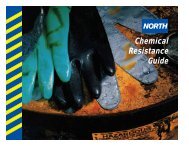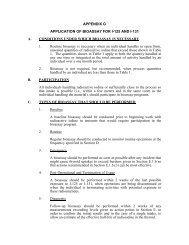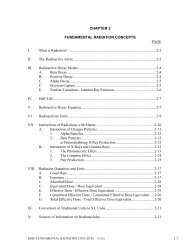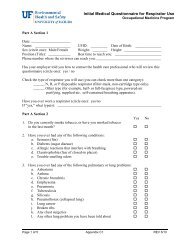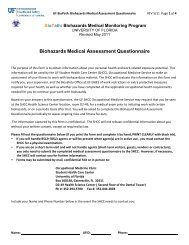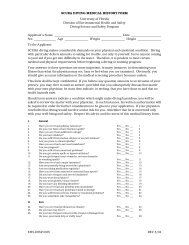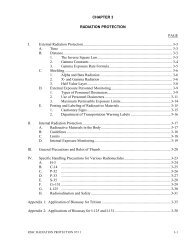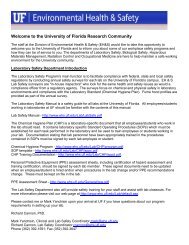Animal Science slaughter facility may be returned there for disposal if not contaminated with infectious,potentially infectious, or recombinant or synthetic nucleic acid material.No animal carcasses or tissue pieces shall be disposed <strong>of</strong> as regular trash or through thebiomedical/biological waste box. Animal carcasses and other animal material that may contain infectiousanimal or human pathogens require containment (red bags, sealed containers labeled with the biohazardsymbol) before moving to Animal Care Services or the Veterinary Medicine disposal facilities.Disposal <strong>of</strong> <strong>Biological</strong> ToxinsBecause they can be extremely hazardous, even in minute quantities, biological toxins require strictsafeguards against their inhalation, absorption through skin or mucous membranes (typically due to asplash), ingestion, or percutaneous injury. Information on the safe use <strong>of</strong> biological toxins can be found at<strong>Safety</strong> and Health Considerations For Conducting Work With <strong>Biological</strong> Toxins and Regulation <strong>of</strong> SelectAgents and toxins, and appendix I <strong>of</strong> the BMBL. The UF Toxin SOP template, the <strong>University</strong> <strong>of</strong> VirginiaBiotoxin Inactivation Table and Table 9 in this manual also provide general guidelines. Specific inactivation and disposal requirements are in place for acute biological toxins. Sometoxins are quite resistant to conventional methods <strong>of</strong> inactivation. These agents cannot be simplyplaced in the biomedical waste or picked up by EH&S Hazardous Waste Services. Each labworking with acute toxins must complete the Acute Toxin SOP which will detailinactivation/disposal requirements for the specific toxin being handled.All liquid waste from toxins must be inactivated and collected by EH&S for disposal as hazardouswaste. Contact the EH&S Hazardous Materials Management Office (352) 392-8400 for toxinwaste pickup.Autoclave Testing and UseThe rules governing the use and testing <strong>of</strong> autoclaves are based on Chapter 64E-16.007 <strong>of</strong> the <strong>Florida</strong>Administrative Code. Autoclaves shall be tested before being placed into service and then periodically foreffectiveness: Every 40 hours <strong>of</strong> use (required for autoclaves that are used to inactivate human or non-humanprimate blood, tissues, clinical samples, or human pathogens.) Every 6 months (required for autoclaves that are used to inactivate other material.)A commercially available test indicator kit that uses bacterial spores (Geobacillus stearothermophilus) isthe approved method <strong>of</strong> testing autoclave efficiency. Most spore vial test kits require 56 0 to 60 0 Cincubation <strong>of</strong> the autoclaved test vial along with a non-autoclaved control vial. Incubation causessurviving spores to grow. Please read the product information sheet for appropriate storage information.Spore vials should not be frozen. Each batch <strong>of</strong> vials has an expiration date; vials should not be usedafter the expiration date.New autoclavesBefore placing an autoclave into service, a test load approximating the weight and density <strong>of</strong> the type <strong>of</strong>waste generated shall be autoclaved with test spore vials. The spore vials should be placed at thebottom, top, front, rear, and center <strong>of</strong> the autoclave chamber. This can be achieved by either:Placing vials at those positions within one large test loadAssembling several smaller test packs with 1 vial at the center <strong>of</strong> each and placing the packs atthose locations within the chamber.The appropriate parameters for sterilization including temperature, pressure, and treatment time shall bedetermined in this way.Autoclaves In-UseFor periodic testing, place a spore vial in the very center <strong>of</strong> a test load prior to autoclaving.Record KeepingThe following records regarding autoclave use must be maintained: Maintenance records45
Autoclave use log must be available near the autoclave; each load <strong>of</strong> material inactivated shall belogged as follows:1. The date, time, and operator name.2. The type and approximate amount <strong>of</strong> waste treated.3. The post-treatment confirmation results by either, a. recording the temperature, pressure, andlength <strong>of</strong> time the waste was treated, or b. the temperature and pressure monitoring indicatorConfirmation <strong>of</strong> sterilization:1. Record the temperature, pressure, and length <strong>of</strong> time the load is sterilized. Please note thattemperature sensitive autoclave tape is not sufficient to indicate that the load achievedsterilization conditions as the tape will change color at lower temperatures.2. Save the autoclave print-out (if the autoclave has a working printer).Autoclave Operating ProceduresA written sterilization procedure shall be in place for each workplace. This shall include the following: Parameters: Appropriate parameters for sterilization shall be determined from the testing withspore vials. The time it takes to sterilize a load will change depending upon the load density andthe sterilization cycle one chooses. Tests have been performed which imitate these varioussituations. Please follow the established guidelines. Protocol: Identification <strong>of</strong> standard treatment containers and proper load placement shall bemade. Cleaning: The autoclave and work areas shall be cleaned after every use and the work area shallbe disinfected, as needed.Autoclave Operation and <strong>Safety</strong> TrainingAutoclave training is provided by the EH&S Biosafety Office upon request. The training is conducted atthe autoclave and is geared toward the research staff. The proper use and maintenance <strong>of</strong> autoclaves aswell as safety training is covered. Please contact the Biosafety Office (352-392-1591) to schedule atraining session.Equipment DecontaminationThe following procedure must be followed before surveying, disposing <strong>of</strong>, moving, or repair <strong>of</strong> UFequipment (e.g. refrigerators, freezers, incubators, biosafety cabinets etc.) that may becontaminated/potentially contaminated with biohazardous material. Wipe the equipment with an appropriate disinfectant (e.g.10% bleach solution followed by 70%ethanol to remove any residual bleach).Biosafety cabinets must be pr<strong>of</strong>essionally decontaminated.Once the equipment is decontaminated, complete the form (see Handouts section) and fax to theBiosafety Office at 352-392-3647.The Biosafety Office will review the form to ensure that the decontamination method used isappropriate and then sign the form. The form will then be returned to the laboratory.Affix the form to the equipment and remove the biohazard sticker on the equipment if present.Note that biosafety cabinets must be re-certified before operating at the new location.The following references were consulted: Disinfection, Sterilization, and Preservation. Fifth edition. 2001. Seymour S. Block ed.,Lippincott Williams & Wilkins, Philadelphia Laboratory Biosafety <strong>Manual</strong>. Third edition. 2004. World Health Organization, Geneva. <strong>Biological</strong> <strong>Safety</strong>: Principles and practices. Third edition. 2000. Diane O. Fleming et al. Eds.ASM Press, Washington DC <strong>Manual</strong> <strong>of</strong> Clinical Microbiology, Volume 1. 9th edition. 2007. Patrick Murray, Ellen Baron, JamesJorgensen, Marie Landry, & Michael Pfaller eds., ASM press, Washington DC Prudent Practices in the Laboratory: Handling and disposal <strong>of</strong> chemicals. 1995 NationalResearch Council. National Academy Press, Washington. Laboratory Decontamination <strong>of</strong> HHS-listed and HHS/USDA Overlap Select Agents and Toxins.Applied Biosafety 2013, Volume 18:2, p.59-7246
- Page 1: UNIVERSITYBiosafetyManual2014OFFLOR
- Page 5 and 6: Hurricane Watch ...................
- Page 7 and 8: Authority & ResponsibilitiesBy auth
- Page 9 and 10: All projects involving recombinant
- Page 11 and 12: Tools for Risk AssessmentBoth the N
- Page 13 and 14: The risk assessment will also deter
- Page 15 and 16: assessments and tests/immunizations
- Page 17 and 18: protection of workers and the envir
- Page 20 and 21: Have limited toxicological data app
- Page 23 and 24: Integration of rAAV genomic sequenc
- Page 26 and 27: from fowlpox virus) are most widely
- Page 28 and 29: S+/L- assay: Vector stocks are ampl
- Page 30 and 31: Kenneth Cornetta, Jing Yao, Aparna
- Page 32 and 33: material. The catalyst for increase
- Page 34: Engineering ControlsThese devices a
- Page 38: PPE to protect eyes and face is use
- Page 41 and 42: DisinfectantsDisinfectants are chem
- Page 43 and 44: Formaldehyde Gas (from heating para
- Page 45: Call Building Services, 294-5500, t
- Page 49 and 50: After the disaster has occurred, de
- Page 51 and 52: Workplace ViolenceAll threats and o
- Page 53 and 54: Account for coworkersWait for any i
- Page 55 and 56: 4. The physician may wish to consul
- Page 57 and 58: Spill Outside the LaboratorySafe tr
- Page 59 and 60: An emergency room should only be us
- Page 61 and 62: staff notifies the PI of any person
- Page 63 and 64: Departments: Assist EH&S in identif
- Page 65 and 66: Investigational New Drug (IND) Vacc
- Page 67 and 68: Transport of Biological Materials o
- Page 69 and 70: All human, animal, or plant pathoge
- Page 71 and 72: Special IssuesHIV Research Laborato
- Page 73 and 74: Symptoms suggestive of B virus infe
- Page 75 and 76: tuberculosis are a potential source
- Page 77 and 78: Table 2. Summary of Recommended Bio
- Page 80 and 81: Table 4: Select Agents and Toxins79
- Page 82 and 83: Table 6: Summary of NIH Guidelines;
- Page 84 and 85: Section Subsection Research Applica
- Page 86 and 87: App C-IVKluyveromyces Host-Vector S
- Page 88 and 89: Table 8: Summary of Biosafety of Vi
- Page 90 and 91: ResourcesBiosafety Resources: http:
- Page 92 and 93: OCCMEDOPIMOSHAPAPRPIPPEPPQPSDSRACrD
- Page 94 and 95: ParenteralPathogenPathogenicityPers
- Page 96 and 97:
Plant, Plant Pests, Noxious Weeds,a
- Page 98 and 99:
Select Agent RegulationsAnimal, Ani
- Page 100 and 101:
Transportation RegulationsTransport




